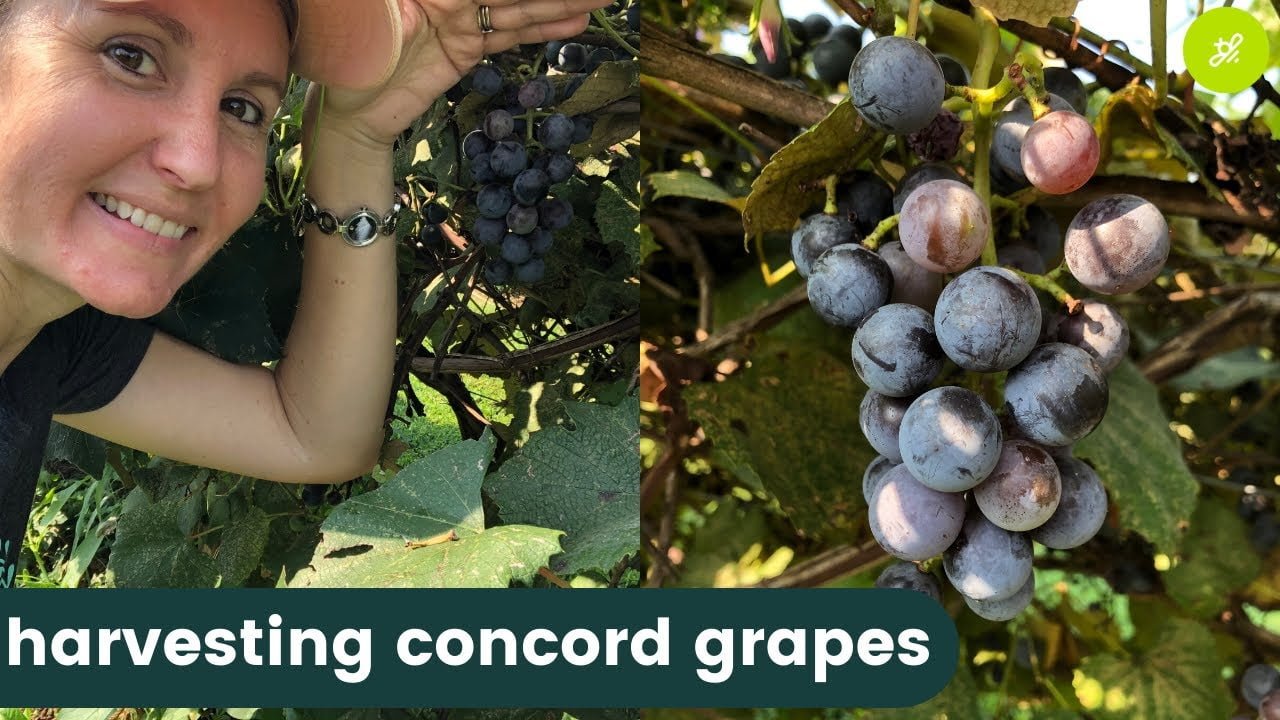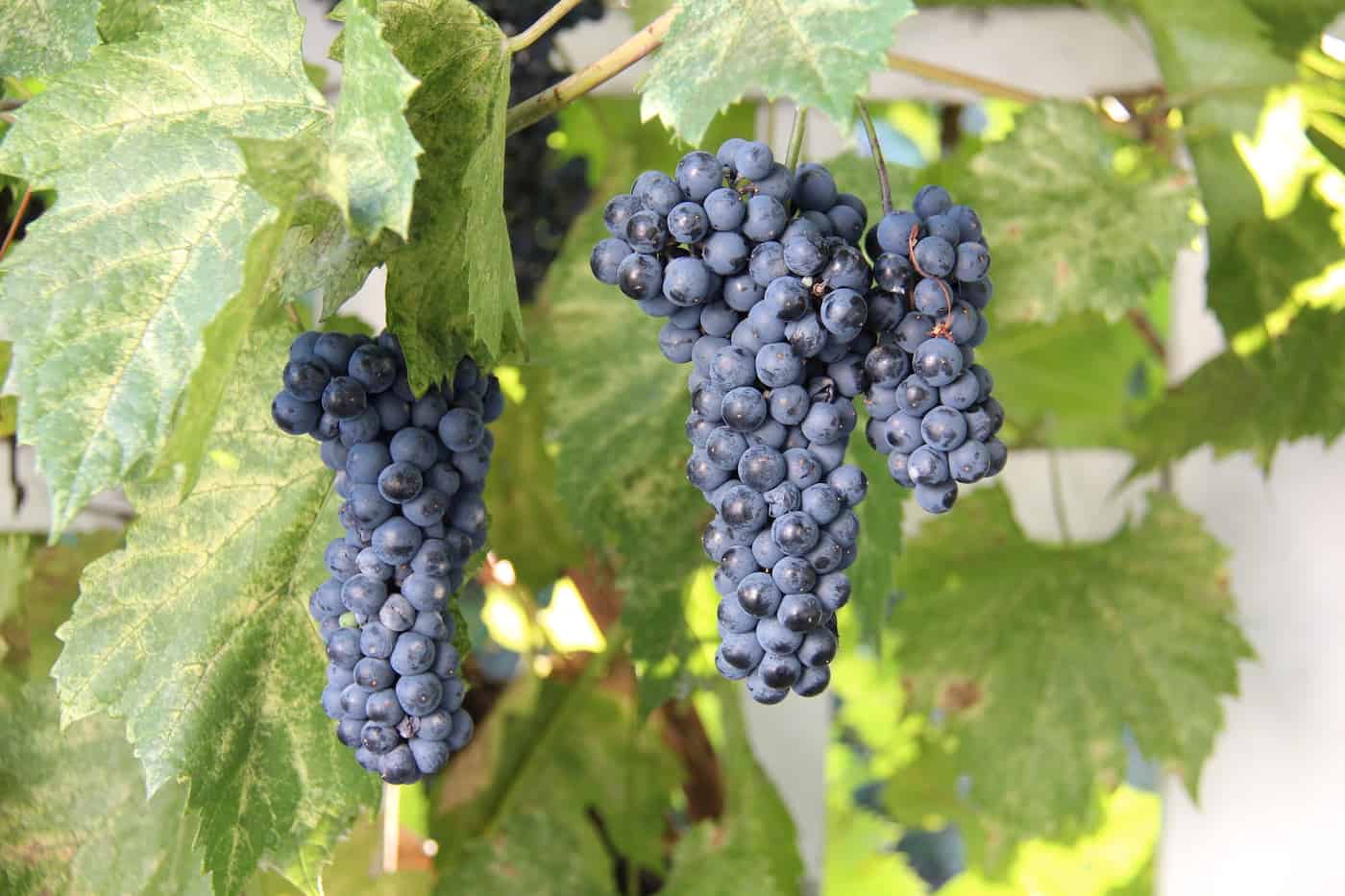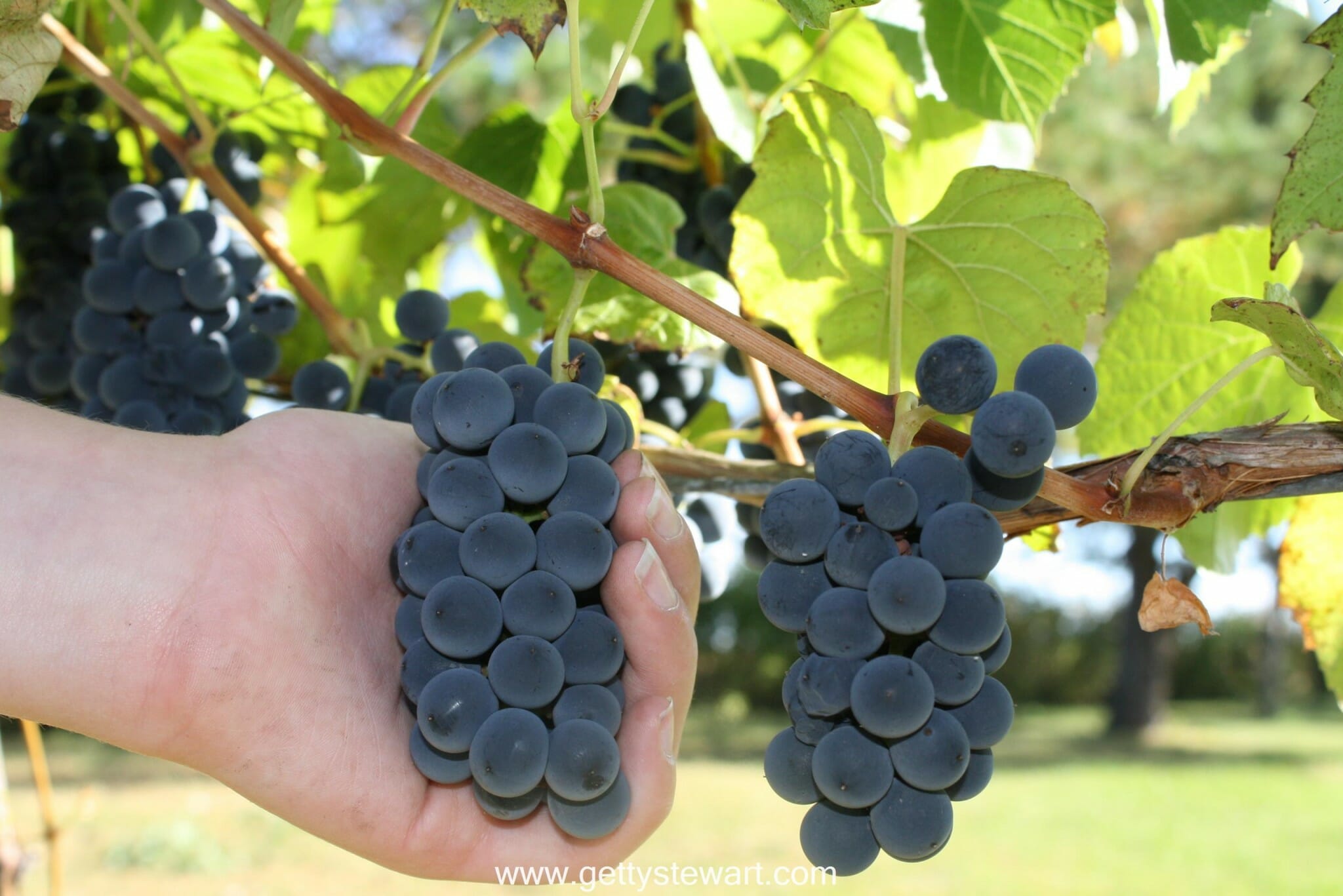Timing is crucial when it comes to harvesting Concord grapes, as it directly impacts their quality and flavor. Concord grapes are at their peak when their skin is deep purple and has a slightly waxy appearance. It is essential to assess their readiness by checking for sugar content and tasting their juiciness. Understanding the signs that indicate the ideal moment for harvest ensures that you can savor the juicy sweetness of Concord grapes at their finest.

Factors Affecting Harvest Time
Climate and Weather Conditions
The climate and weather conditions play a crucial role in determining the ideal harvest time for grapes. The overall temperature, humidity, and sunlight levels throughout the growing season affect the grapes‘ development and maturity. Grapes require a specific amount of heat and sunlight to ripen properly. Cooler climates may lead to delayed harvest, while warmer climates might result in early harvest. Extreme weather events such as heavy rains or frost can also impact the harvest time. It is essential to closely monitor and analyze the climatic conditions to determine the optimal timing for grape harvesting.
Grape Appearance
Grape appearance is another factor that helps determine the harvest time. As grapes mature, their appearance undergoes noticeable changes. The color of the grape berries can vary depending on the grape variety, but as they near maturity, the color intensifies and becomes more uniform. Grapes that are ready for harvest develop a rich and vibrant color, indicating their optimal ripeness. Additionally, the size and shape of the grape clusters can provide valuable insights into the grape maturity. Monitoring the visual appearance of the grapes is a useful indicator in determining the ideal harvest time.
Sugar Level and Acidity
The sugar level and acidity of grapes are critical factors in determining their harvest time. As grapes mature, the sugar content increases while the acidity decreases. The balance between sugar and acidity greatly influences the grape’s taste, flavor profile, and ultimately, the quality of the resulting wine. To accurately assess the sugar level, the Brix scale is often used, which measures the grape’s sugar concentration. Monitoring both sugar levels and acidity throughout the growing season helps determine the point at which the grapes have reached the desired balance and are ready to be harvested.
Physical Grape Maturity Signs
Skin Color
The color of the grape skins is an essential physical indicator of grape maturity. As grapes ripen, their skin color changes, becoming darker and more vibrant. For red grapes, the skin transitions from green to shades of purple, red, or black, depending on the variety. White grapes develop a golden or yellow color. This change in skin color signifies that the grapes have accumulated the necessary pigments and compounds associated with their ripeness. By monitoring the skin color, vineyard managers and winemakers can determine when the grapes are ready for harvesting.
Firmness of Grapes
The firmness of grapes is another physical sign of their maturity. With time, grapes transform from being firm to slightly soft. This softening indicates that the grapes have reached their optimal maturity level. Measuring the firmness of grapes can be done visually or by gently squeezing them. However, it is important not to handle the grapes too roughly to prevent damaging them. Monitoring the grapes’ firmness provides valuable information about their readiness for harvest and the desired texture of the resulting wine or grape products.
Berry Size
The size of the grape berries is also a physical indicator of their maturity. As grapes ripen, they tend to increase in size. Monitoring the berry size allows vineyard managers to track the grapes’ development and estimate their maturity level. However, it is important to note that different grape varieties have different natural sizes, so one should primarily focus on the changes in size throughout the growing season. Comparing the berry size with previous vintages or the average size for the particular grape variety can provide useful insights into the grapes’ maturity.

Brix Levels and Acidity
Importance of Brix Levels
Brix levels are a crucial measurement to determine the sugar concentration in grapes, which directly affects their potential for winemaking. The Brix scale measures the percentage of sugar in the grape juice or must. This measurement is valuable in determining the grapes’ overall ripeness and their suitability for different wine styles. The desired Brix levels can vary depending on the wine style, grape variety, and the winemaker’s preferences. The Brix level impacts the potential alcohol content of the wine and can provide insight into the grape’s flavor development.
Measuring Brix Levels
Measuring Brix levels requires the use of a refractometer or a hydrometer, instruments specifically designed for this purpose. These instruments calculate the Brix level based on the grape juice’s specific gravity, which is influenced by its sugar content. To measure the Brix level accurately, it is essential to extract representative grape juice samples from various locations in the vineyard. Sampling from different vines and clusters ensures a comprehensive assessment of the grape maturity. Measuring the Brix level alongside other factors such as acidity helps determine the optimal harvest time.
Determining Acidity
In addition to monitoring the sugar levels, assessing the grape’s acidity is crucial for determining its maturity and suitability for winemaking. The grape’s acidity contributes to its flavor profile, freshness, and aging potential. While grapes generally become less acidic as they ripen, determining the ideal acidity level depends on the targeted wine style and the grape variety. Measuring the grape’s pH and titratable acidity provides valuable information about its acid composition. Vineyard managers and winemakers can use this information to make informed decisions regarding the optimal harvest time.
Taste and Flavor
Sampling Grapes
Sampling the grapes is an integral part of assessing their taste and flavor development. To accurately evaluate the grapes’ maturity, it is essential to perform regular tastings throughout the growing season. Sampling involves carefully selecting representative grape clusters from different areas of the vineyard. These grapes are then sampled to assess their taste, sweetness, acidity, and flavor intensity. By tasting the grapes, vineyard managers and winemakers can gain valuable insights into the grapes’ flavor profile and make informed decisions about the ideal harvest time.
Taste Test
Conducting taste tests is a critical step in determining the readiness of the grapes for harvest. During the taste test, the grapes are evaluated based on their sweetness, acidity, and balance. Grapes that are too tart or lack sufficient sweetness may need more time to ripen fully. On the other hand, overly sweet grapes may indicate overripeness, which can affect the resulting wine’s quality. An ideal taste test involves comparing the grapes’ flavors to the desired taste profile for the intended wine style. By conducting taste tests, vineyard managers can ensure that the grapes are harvested at their peak flavor.
Flavor Development
The flavor development of grapes is a complex process influenced by various factors, including sugar accumulation, acid degradation, and the synthesis of aroma compounds. As grapes mature, their flavor profile evolves, and they develop unique characteristics. Monitoring the grapes’ flavor development involves assessing their taste components, aromatic intensity, and overall flavor balance. Grapes with well-developed and complex flavor profiles are often preferred for winemaking. By closely monitoring the flavor development, vineyard managers can determine the optimal harvest time to ensure the desired flavor characteristics in the resulting wine.

Cultural Practices to Monitor
Checking for Insect Damage
Insects can cause significant damage to grapevines and affect the grapes’ quality and ripening process. Regular inspection of the grapevines is essential to detect and address any signs of insect infestation. Insects such as grapevine moths, mealybugs, and aphids can cause direct damage to the grape clusters and leaves, impacting the grapes’ maturity. Implementing effective pest control strategies and monitoring the vineyard for insect damage helps ensure healthy grape development and minimize potential harvest time delays.
Monitoring Disease Pressure
Diseases can severely impact grapevines and hinder their proper development and maturation. Common grapevine diseases such as powdery mildew, downy mildew, and botrytis can affect the grapes’ appearance, flavor, and overall quality. Regular monitoring of the vineyard for disease symptoms is crucial to detect any early signs of infection. Implementing preventive measures such as proper vineyard management techniques, disease-resistant grape varieties, and targeted disease control strategies can minimize disease pressure and ensure the grapes are harvested at their optimal state.
Pruning Considerations
Proper pruning practices contribute to vineyard health and grape development. Pruning involves selectively removing certain parts of the vine, such as shoots and canes, to promote the desired growth and fruit production. Regularly monitoring and adjusting the pruning techniques based on the vine’s vigor, growth patterns, and fruit load can optimize the grape development. Pruning considerations include maintaining a balanced vine canopy, ensuring sufficient sunlight exposure, and managing the vine’s growth to support optimal fruit ripening. By implementing appropriate pruning practices, vineyard managers can enhance grape quality and facilitate timely harvest.
Cluster Ripening
Observing Change in Cluster Appearance
Observing the change in cluster appearance is a critical aspect of assessing cluster ripening. As grapes mature, the cluster appearance undergoes noticeable changes. The color and texture of the grape berries within the cluster become more uniform and vibrant. Additionally, the grape berries slightly soften, indicating their increased ripeness. Monitoring the cluster appearance helps identify clusters that are ready for harvest, ensuring that only fully ripe grapes are selected, contributing to the overall quality of the grapes and resulting wine.
Testing Berry Firmness
Berry firmness is a physical characteristic that provides insights into the grape’s ripeness and readiness for harvest. As grapes mature, they transition from being firm to slightly soft. Testing berry firmness involves gently squeezing a representative sample of grapes from different clusters and vines. The grapes should offer a slight resistance to pressure without being overly firm or too soft. This technique helps assess the ripeness level of the grapes and ensures that they have reached the desired readiness for harvest.
Monitoring Berry Color
Monitoring the color of the individual grape berries within the cluster is another way to determine cluster ripening. As grapes mature, their color intensifies and becomes more uniform. For red grapes, the color transitions from green to shades of purple, red, or black. White grapes develop a golden or yellow color. By monitoring the berry color within the cluster, vineyard managers can identify the stage of ripening and select the clusters that have achieved the desired color for harvest. This technique contributes to the consistent quality of the harvested grapes.

Watch for Birds and Other Wildlife
Protecting Clusters from Birds
Birds can be a significant threat to grape clusters, especially as they approach maturity. Birds are attracted to the sweetness and flavors of ripening grapes, which can lead to significant crop losses. Implementing bird control measures, such as installing bird netting or scare devices, helps protect the grape clusters from bird damage. Regular monitoring of the vineyard for bird activity is essential to detect any signs of potential damage and take preventive actions in a timely manner. Protecting the clusters from birds ensures the grapes remain intact and ready for an optimal harvest.
Monitoring Presence of Wildlife
In addition to birds, other wildlife can also pose a threat to grape clusters. Animals such as deer, rabbits, and rodents may cause damage to the vineyard, including feeding on grape leaves and clusters. Monitoring the vineyard for the presence of wildlife is crucial to assess the potential risks and implement appropriate preventive measures. Fencing the vineyard, using deterrents, or employing other wildlife management techniques can help minimize the damage caused by wildlife and safeguard the grapes for harvest.
Timing Considerations
Harvesting for Fresh Consumption
When harvesting grapes for fresh consumption, the timing is crucial to ensure peak flavor and quality. Grapes destined for the fresh market are typically harvested slightly earlier than those intended for winemaking. The desired characteristics for fresh consumption include a balance between sweetness and acidity, crisp texture, and vibrant flavors. Conducting regular taste tests and flavor assessments helps determine the optimal harvest time for grapes that will be consumed fresh. Additionally, selecting grape varieties known for their flavor and suitability for fresh consumption contributes to a successful harvest.
Harvesting for Winemaking
For winemaking purposes, the ideal harvest time depends on the desired wine style and grape variety. In general, grapes harvested for winemaking are allowed to develop a higher sugar concentration and lower acidity compared to those for fresh consumption. Vineyard managers and winemakers closely monitor the grapes’ sugar levels, acidity, taste, and flavor development to determine the optimal harvest time. Harvesting at the right moment ensures that the grapes possess the desired attributes for the intended wine style, contributing to the quality and character of the final product.

Testing the Vineyard
Checking Multiple Grape Samples
When determining the harvest time, it is important to check multiple grape samples within the vineyard. Each vine, cluster, and even individual berry within a cluster may exhibit variations in maturity and readiness for harvest. By assessing multiple samples, vineyard managers can obtain a comprehensive view of the vineyard’s overall maturity and ensure that the grapes are harvested uniformly. Sampling from different vineyard sections, soil types, and exposures helps capture the vineyard’s variability and make informed decisions about the optimal harvest time.
Taking Notes on Grape Development
Accurate record-keeping is essential for monitoring grape development and determining the harvest time. Taking detailed notes throughout the growing season allows vineyard managers to track the grapes’ progress, such as changes in appearance, Brix levels, acidity, taste, and flavor development. These records provide valuable historical information that can be used for future reference and decision-making. By maintaining comprehensive notes, vineyard managers can analyze trends and patterns, make adjustments to vineyard practices, and fine-tune the harvest timing based on past experiences.
Assessing Overall Vineyard Ripeness
Assessing the overall ripeness of the vineyard involves combining information from various factors, including grape appearance, sugar levels, acidity, taste, and flavor development. By considering these multiple indicators together, vineyard managers can make a comprehensive evaluation of the vineyard’s readiness for harvest. Intuition and experience also play a role in assessing overall vineyard ripeness. Vineyard managers become familiar with the specific characteristics of their vineyard and grape varieties, expanding their ability to make informed decisions about the optimal harvest time.
Harvest Methods and Techniques
Hand Harvesting
Hand harvesting involves manually picking the grapes from the vine. This method provides precise control over grape selection, ensuring that only the ripest and highest-quality grapes are harvested. Hand harvesting is often preferred for grape varieties that require careful handling, such as those used for premium and boutique wines. Skilled labor is required for hand harvesting, and the process can be time-consuming and labor-intensive. However, the manual selection and gentle handling of the grapes contribute to the preservation of their quality and the resulting wine’s excellence.
Machine Harvesting
Machine harvesting involves the use of specialized machines designed to harvest grapes mechanically. This method is quicker and more efficient than hand harvesting, making it suitable for larger vineyards and grape varieties that do not require meticulous selection. However, machine harvesting may be less precise in terms of grape selection and can potentially damage the grapes if not properly calibrated and operated. Proper vineyard management, including regular canopy maintenance and appropriate training systems, ensures the suitability of machine harvesting. Advances in technology continue to refine machine harvesting techniques, enhancing its accuracy and efficiency.
Practices for Quality Control
Quality control practices are essential during harvest to ensure that the grapes meet the desired standards for winemaking. This involves inspecting the harvested grapes for any signs of rot, disease, or insect damage. Proper sanitation measures should be in place to prevent contamination and maintain the grape’s quality. The grapes should be carefully transported from the vineyard to the winery to minimize any potential damage. Quick processing of the grapes after harvest helps preserve their freshness and integrity. Implementing rigorous quality control practices contributes to the production of high-quality wines and grape products.
In conclusion, determining the ideal harvest time for grapes requires careful consideration of multiple factors. Climate and weather conditions, grape appearance, sugar levels, acidity, taste and flavor development, cultural practices, cluster ripening, wildlife presence, timing considerations, vineyard testing, and harvest methods all play a role in determining when to harvest grapes. By monitoring and assessing these factors, vineyard managers and winemakers can make informed decisions to ensure the grapes are harvested at their peak ripeness, resulting in higher-quality grapes and exceptional wines.



